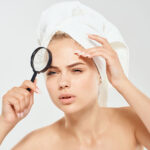To answer these questions you have to know the causes that cause acne and we will talk about these causes, how to fight acne and why.
What is acne?
Acne is a chronic disease of the skin, exactly the problem is in the pilosebaseous unit, that is, in a structure from which the hair comes out that is contiguous to the sebaceous gland (the one that produces fat), it appears in adolescence and the good The news is that it evolves towards its improvement as age passes, and it is also good to know that generally oily skin wrinkles less , so encourage those who suffer from acne because there are currently very effective treatments to combat it.
What are the triggers?
- Hormonal changes , that is why acne begins at puberty with the maximum peak in adolescence, the cause is testosterone, a hormone that stimulates the sebaceous gland and therefore begins to produce more sebum (fat) than normal .
- Once this fat is formed, the thickened skin (what we medically call hyperkeratinization of the skin) means that this type of skin does not let the sebum out easily, the sebaceous gland begins to enlarge and become inflamed, damaging the surrounding structures and skin.
- In this environment where there is overproduction of fat, p.acnes (bacteria related to acne) begins to proliferate and cause the pus of the pimples that we see on the face when an outbreak begins.
- Consequently, we find the inflammation and infection of this pilosebaceous unit that causes pain and aesthetically prompts us to squeeze the pimples and release this pus that hurts so much and aesthetically makes us feel bad …
Why should we treat them with peels?
Since the first factor is uncontrollable, and hormonal changes in adolescence are necessary, and there is a certain genetic predisposition to have more oily or less oily skin; So where we can act and help fight acne is in the 2nd factor, how?
Treating the skin topically with peels, what for?
To treat the 2nd factor that would be to release the thickened skin (hyperkeratinized) thanks to the “peeling” effect of the peels in this way we facilitate the exit of this clogged fat without leaving it, thus avoiding a consequent inflammation and more severe infections, which at the end of the day once the inflammation and infection have passed would produce the dreaded sequelae: the scars that cause the skin to sag that sometimes not even with makeup are covered by the great injury that they have caused inside the skin called ” fibrosis “and also the spots that they produce once they have healed.
Current peels are very safe and effective because they allow a controlled and risk-free peeling, producing a better quality of the skin, less thickened and more hydrated, which allows a smoother peeling, in this way the skin will release excess fat in more natural. There are currently various concentrations of peels, the most effective are medical peels because their concentrations are very high, but they must necessarily be controlled and treated by an aesthetic doctor, dermatologist, etc., who is properly trained for such a procedure.
Another reason why this pathology should be treated by a doctor is because in addition to peelings there are other treatments such as oral ones; antibiotics, retinoids, etc., but in order to decide which is the most indicated treatment, the doctor must explore the lesions and classify the acne within a scale: mild, mild-moderate, moderate, severe acne, acne conglobata (the most severe), and based on the patient’s clinical situation, choose the best treatment for each case, since not all will be treated in the same way and with the same intensity.
In my daily practice I also give cosmetic counseling that I consider one of the pillars so that at least their situation does not aggravate, because many times patients bring me many creams and products that are applied daily to the consultation, and many of them are counterproductive for acne, that is, they make it worse.
Once I indicate the treatment in the consultation, I apply the peeling , I also advise home treatment, which is very important so that the effects of the peels last over time and the acne improves and the patient knows how to properly treat acne at home.
At the same time, I also consider it important to treat and nourish the skin from within with homeopathy (plant and mineral extracts), vitamins, in addition to the invaluable micronutritional counseling that obviously and substantially improve the quality of the skin.
I sincerely hope that this article has been of your interest, since acne causes a lot of suffering and social disconfot to those who suffer from it, but we encourage all of them because there are currently very effective and safe treatments.
When is the best time to treat acne?
Autumn and winter are the best times to treat acne , because there is no sun, and we will avoid unnecessary risks of skin pigmentation, since when performing the peels it is very exposed to the sun’s rays.




GIPHY App Key not set. Please check settings